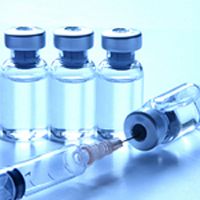Publication
Article
Targeted Therapies: Multiple Sclerosis
Teva's Copaxone Now Available in a 3-Times-Weekly Regimen
Author(s):
Last year, Copaxone received US Food and Drug Administration (FDA) approval for a new 40-mg/mL subcutaneous injection used 3 times weekly, allowing for less frequent administration of the medication than the original 20-mg/mL daily subcutaneous injection.

Glatiramer acetate (Copaxone) is an injectable treatment for relapsing-remitting multiple sclerosis (RRMS) that has been in use since 1996. In January 2014, Copaxone received US Food and Drug Administration (FDA) approval for a new 40-mg/mL subcutaneous injection used 3 times weekly, allowing for less frequent administration of the medication than the original 20-mg/mL daily subcutaneous injection.
Copaxone is indicated to reduce the risk of relapses in patients with RRMS 18 years or older.1,2 Contraindications for use of Copaxone include having a hypersensitivity to its active ingredient (glatiramer acetate) or to a component of the formulation, mannitol. Copaxone should never be administered intravenously.2
Pharmacology and Pharmacokinetics
Although scientists do not fully understand the mechanism of its action, Copaxone is thought to modify immune processes that contribute to the pathology of MS. In an animal model of MS, known as autoimmune encephalomyelitis, administration of Copaxone increased the activity of suppressor T cells.2 The active ingredient of Copaxone contains an acetate salt of a synthetic polypeptide chain of 4 amino acids: L-glutamic acid, L-alanine, L-tyrosine, and L-lysine. Each molecule ranges in size from 5000 to 9000 daltons. Because of its large atomic weight, a proportion of the active ingredient in each dose of Copaxone is broken down locally by hydrolytic enzymes; however, the existence of antibodies specific to the active ingredient in Copaxone indicates that some of the medication enters the systemic circulation and lymphatic system intact.2
In patients with impaired renal function or in those who are breast-feeding, the pharmacokinetic parameters of Copaxone have not been studied. As a result, the package insert provides no recommendations for dosage adjustment in patients with renal disease or hepatic disease and makes no specific recommendations about use in breast-feeding populations.2
Dosage and Administration
Copaxone should be stored under refrigeration between 36°F and 46°F. Although storage between 59°F and 86°F (room temperature) is permitted for up to 1 month, refrigeration ensures product potency. Patients should be cautioned to avoid exposure of Copaxone to high temperatures or intense light.2
Before administration, the syringe should be inspected for particulate matter. Any syringe containing visible particulate matter should not be used. The solution may be clear or colorless or have a slight yellow tinge.2
Each prefilled subcutaneously administered syringe of Copaxone should be removed from refrigeration before injection and should be allowed to warm to room temperature for over at least 20 minutes before administration. Copaxone is now available in a prefilled 40-mg/mL syringe containing a volume of 1 mL for subcutaneous injection. Subsequent doses should be administered at least 48 hours apart. It is important to note that, in addition to the 3-times-weekly injection, Copaxone is available in the original prefilled 20-mg/mL 1-mL syringe for daily injection.2
Subcutaneous injection is accomplished by cleaning the injection area with an alcohol wipe; pinching a layer of skin located on the arms, abdomen, hips, or thighs; inserting the syringe perpendicular to the skin surface; injecting the contents of the syringe; and carefully withdrawing the syringe through the same path of entry. The single-use syringe should then be disposed of in a sharps container, and a sterile cotton ball should be placed over the injection site.
Typically, the first administration of Copaxone is carried out by a physician or a nurse, either during a home visit or in an office setting. After the first administration, patients may self-administer the injection. Patients self-administering Copaxone should be advised to rotate the injection site to reduce the risk of lipoatrophy.2
Clinical Trials
Of clinical trials evaluating the efficacy of Copaxone in RRMS, 4 prior placebo-controlled studies support the efficacy of Copaxone daily, and 1 large trial supports efficacy of the new 3-times-weekly injection.2
In this double-blind, placebo-controlled study of 1404 patients, 943 receiving Copaxone and 461 receiving placebo, investigators at several sites around the world confirmed the efficacy of Copaxone 40 mg/mL in neurologic outcomes and magnetic resonance imaging (MRI) measures of disease progression.2
Using the Expanded Disability Status Scale (EDSS), which ranges from 0 (a normal examination result) to 10 (death due to MS), investigators ensured that all patients had a baseline EDSS score ≤5.5. EDSS was reevaluated every 3 months and as needed during unscheduled physician visits resulting from MS relapses. MRI results were recorded at baseline, month 6, and month 12, or before study termination. The primary outcome was the number of confirmed relapses that occurred during the study period.2,3
Of patients taking Copaxone, the average number of relapses per patient was 0.331/year, compared with an average of 0.505/year for patients taking placebo, for a significant 34% relative risk reduction in the likelihood of experiencing a relapse (P <.0001). Fewer new or enlarging T2 lesions or enhancing T1 lesions on MRI images appeared in patients taking Copaxone than in patients using placebo during the study period (P <.0001). Completion rates of the entire 12-month study were 93% with placebo treatment and 91% with Copaxone therapy.2
Warnings and Precautions
Copaxone has been studied with concurrent use of up to 28 days of corticosteroid treatment. Although drug interactions have not been fully evaluated,studies of treatments typically used in patients with MS do not indicate clinically relevant interactions with Copaxone. Based on animal data, Copaxone is a pregnancy category B medication. No adequate, well-controlled trials in pregnant women have been conducted.2
Injection-site reactions, vasodilation, rash, dyspnea, and chest pain occurred in ≥10% of patients using Copaxone, a rate which was at least 50% higher than that observed in patients receiving a placebo injection. Other common reactions included flushing, chest pain, palpitations, anxiety, dyspnea, and throat constriction.
Patients should be advised that these generally transient symptoms typically occur shortly after an injection.2
References
1. Teva announces US FDA approval of three-times-a-week COPAXONE (glatiramer acetate injection). 40mg/mL. Teva Pharmaceutical Industries Ltd website. www.tevapharm.com/Media/News/Pages/2014/1894510.aspx?year=2014. Accessed March 2014.
2. COPAXONE (glatiramer acetate injection) [package insert]. North Wales, PA: TEVA Pharmaceuticals USA, Inc; 2014.
3. Extended Disability Status Scale (EDSS). FDA website. www.fda.gov/ohrms/dockets/ac/00/backgrd/3582b1px.pdf. Accessed March 2014.






